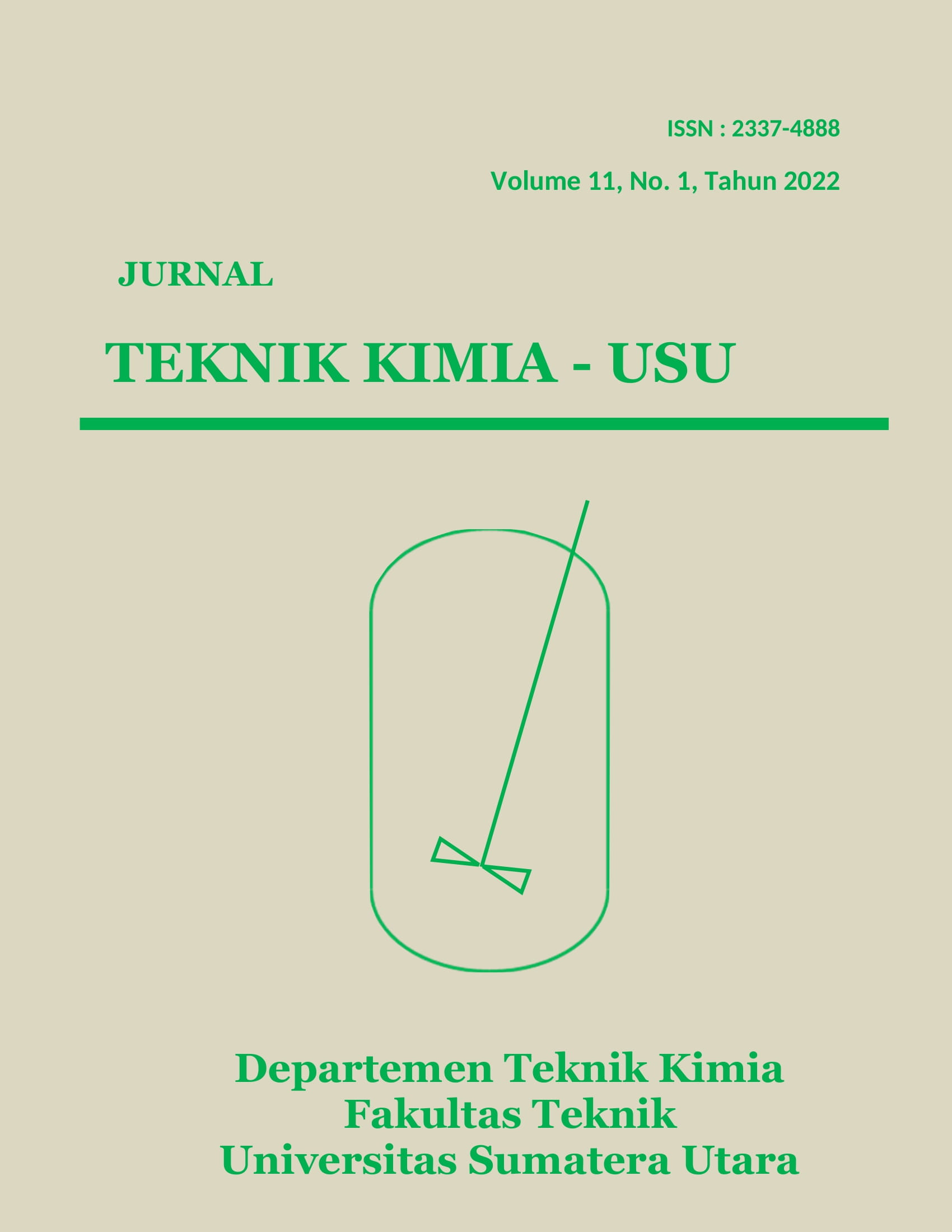Pengaruh Penambahan Co-solvent Metil Ester dan Waktu Reaksi pada Proses Transesterifikasi Minyak Kelapa Sawit Menjadi FAME (Fatty Acid Methyl Esters)
DOI:
https://doi.org/10.32734/jtk.v11i1.7668Keywords:
biodiesel, co-solvent methyl ester, transesterification, yield FAMEAbstract
Biodiesel is a renewable energy that is expected to replace diesel. The process of making biodiesel is constrained due to the limited solubility of the reactants. One way to increase the solubility is to add a co-solvent that can dissolve polar and non-polar materials. Methyl ester is the best co-solvent because it is cheap and can shorten the stages of the biodiesel manufacturing process. The aim of the research was to obtain the optimum conditions for the transesterification process with the addition of co-solvent methyl ester. The operating conditions of the study were palm oil raw material, 1% NaOH catalyst mass, oil : methanol molar ratio = 1:6, stirring speed 100 rpm, reaction temperature 70 â°C, reaction time (5 minutes, 10 minutes, 15 minutes, 20 minutes, 25 minutes, 30 minutes) and the mass of co-solvent (0%, 5%, 10%, 15%). The optimum conditions of the study obtained the optimum FAME yield of 57.33% in the transesterification reaction of palm oil with 15% co-solvent methyl ester at a reaction time of 15 minutes. At the optimum condition obtained FAME concentration of 96.63% which meets SNI 7182-2015.
Downloads
References
Jimmy, “Kinetika reaksi transesterifikasi minyak kelapa sawit,†Tek. Kim., vol. 7, no. 1, pp. 12–17, 2012.
E. D. Daryono, I. N. G. Wardana, C. Cahyani, and N. Hamidi, “Biodiesel production process without glycerol by-product with base catalyst: effect of reaction time and type of catalyst on kinetic energy and solubility,†IOP Conf. Ser. Mater. Sci. Eng., vol. 1053, no. 012058, pp. 1–7, 2021.
E. D. Daryono and L. Mustiadi, “Penggunaan metil ester sebagai co-solvent pada proses transesterifikasi minyak kelapa sawit menjadi biodiesel,†Pros. Semin. Nas. Rekayasa Proses Ind. Kim., vol. 1, pp. 27–33, 2017.
H. N. T. Le et al., “Biodiesel production from rubber seed oil by transesterification using a co-solvent of fatty acid methyl esters,†Chem. Eng. Technol., vol. 41, no. 5, pp. 1013–1018, 2018.
N. H. P. Uyen et al., “A new method for production of green biodiesel fuel using FAME as a co-solvent,†Eco-Engineering, vol. 32, no. 3, pp. 61–67, 2020.
Muyassaroh, E. D. Daryono, and M. I. Hudha, “Biodiesel dari minyak jarak pagar dengan variasi penambahan co-solvent dan waktu reaksi,†Tek. Kim., vol. 7, no. 1, pp. 8–11, 2012.
E. D. Daryono and E. J. Sinaga, “Transesterification of palm oil with NaOH catalyst using co-solvent methyl ester,†Int. J. ChemTech Res., vol. 9, no. 12, pp. 570–575, 2016.
E. D. Daryono and E. J. Sinaga, “Rapid in situ transesterification of papaya seeds to biodiesel with the aid of co-solvent,†Int. J. Renew. Energy Res., vol. 7, no. 1, 2017.
R. F. Yudha, A. Setiawan, and N. Eka Mayangsari, “Identifikasi komponen FAME (Fatty Acid Methyl Ester) pada biodiesel yang disintesis dari minyak goreng bekas,†Waste Treat. Technol., pp. 91–96, 2017.
E. Marlina, M. Basjir, M. Ichiyanagi, T. Suzuki, G. J. Gotama, and W. Anggono, “The role of eucalyptus oil in crude palm oil as biodiesel fuel,†Automot. Exp., vol. 3, no. 1, pp. 33–38, 2020.
Downloads
Published
Issue
Section
License
Copyright (c) 2022 Jurnal Teknik Kimia USU

This work is licensed under a Creative Commons Attribution-ShareAlike 4.0 International License.

















